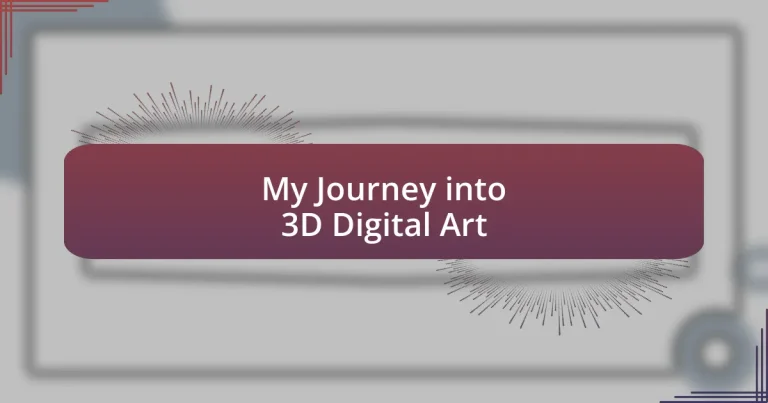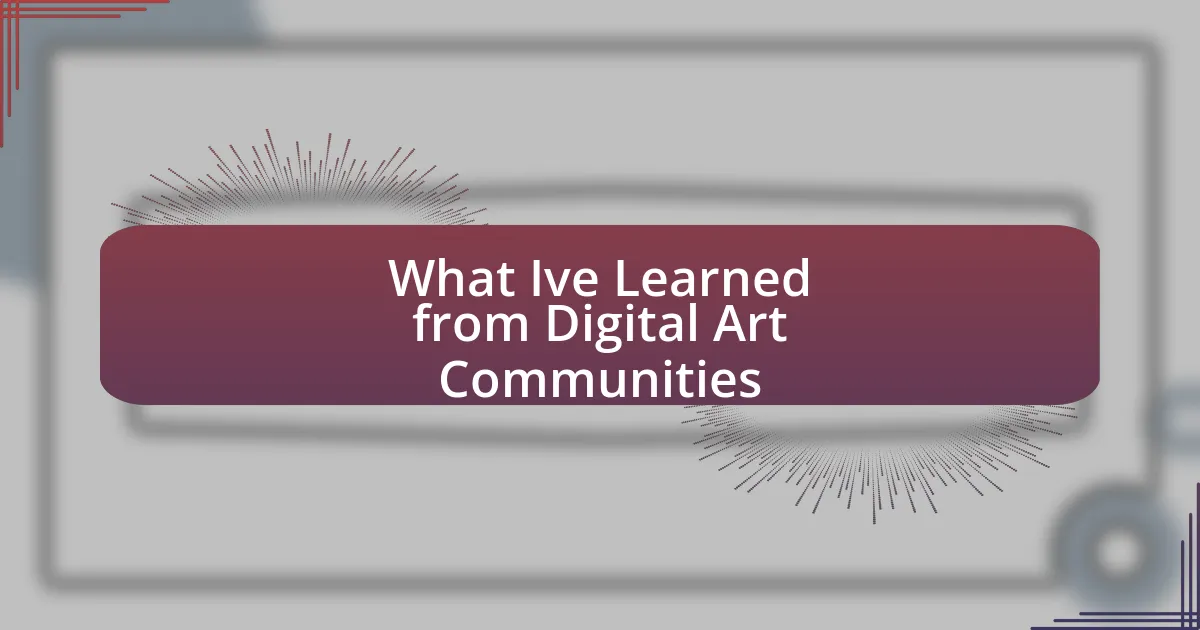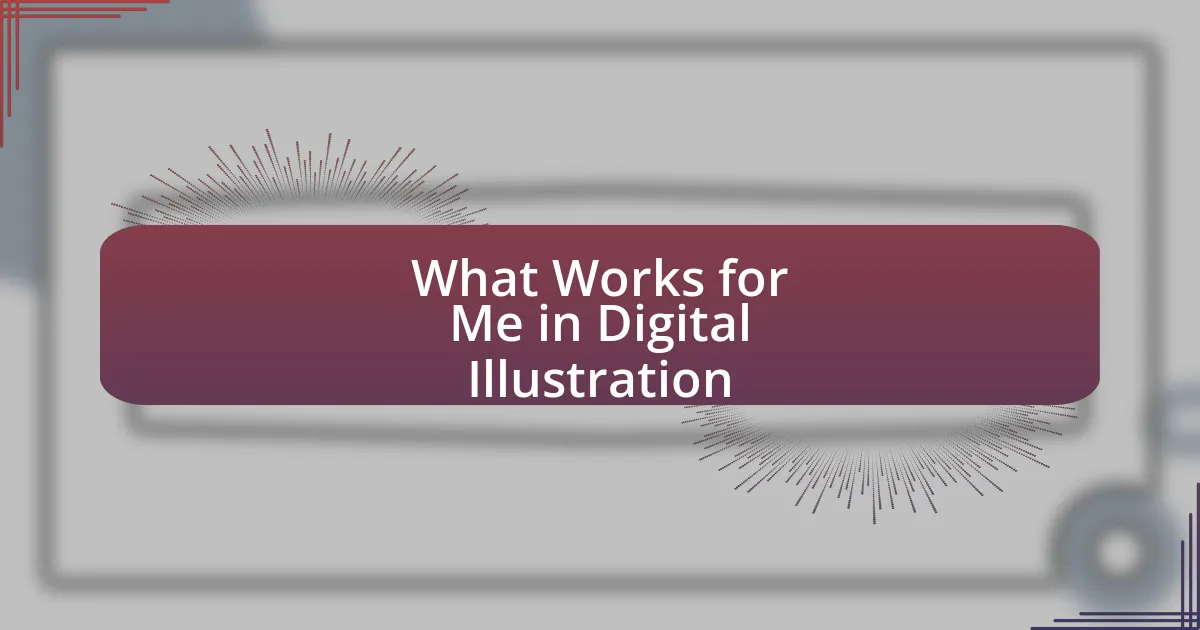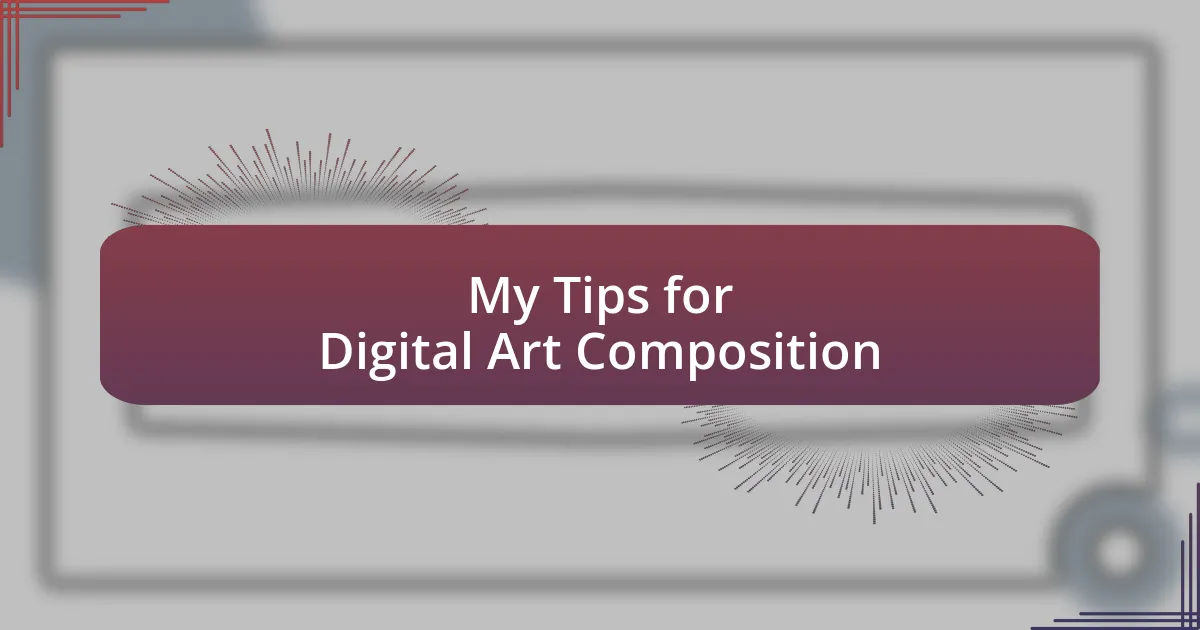Key takeaways:
- The author’s initial inspiration in 3D art stemmed from artists like H.R. Giger and experiences at local art exhibitions, fueling their creative journey.
- Exploration of different software tools, particularly Blender and ZBrush, significantly enhanced the author’s modeling and detailing skills.
- Collaboration and learning from tutorials played a crucial role in refining the author’s techniques and expanding their artistic perspective.
- Overcoming challenges such as creative blocks and software changes taught the author resilience and adaptability in their artistic process.
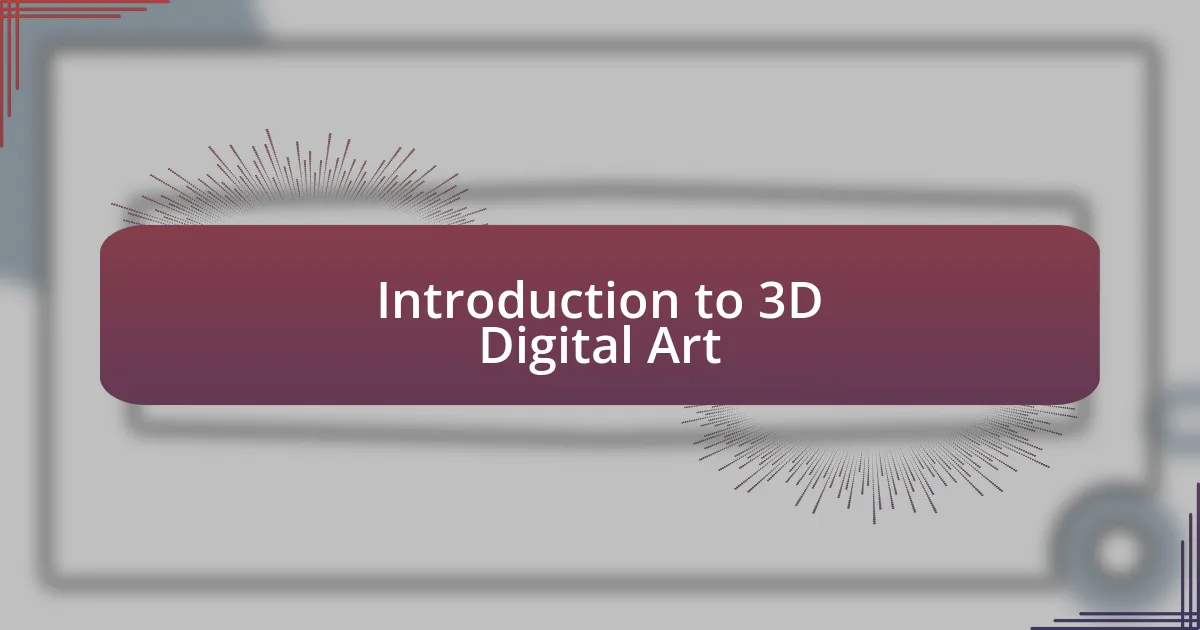
Introduction to 3D Digital Art
Diving into 3D digital art is like stepping into a new dimension, one that offers endless possibilities for creativity. I still remember the first time I manipulated a digital model—it felt exhilarating, almost like having superpowers. The ability to mold shapes and textures with just a few clicks was a revelation, igniting a passion that has only grown over time.
3D digital art transcends traditional boundaries, combining technology with artistic vision in a unique way. Have you ever marveled at how a simple geometric shape can transform into a lifelike character or an intricate environment? It’s fascinating how the tools available today allow both novices and seasoned artists to create stunning visuals that were once the realm of imagination alone.
As I explored different software options—each with its own quirks and strengths—I felt a mix of frustration and excitement. Finding the right tools to bring my visions to life was a journey in itself. But each challenge taught me something valuable, whether it was about perspective, lighting, or even color theory. This exploration not only enriched my skills but also deepened my appreciation for the art form and its potential to convey emotion and story.
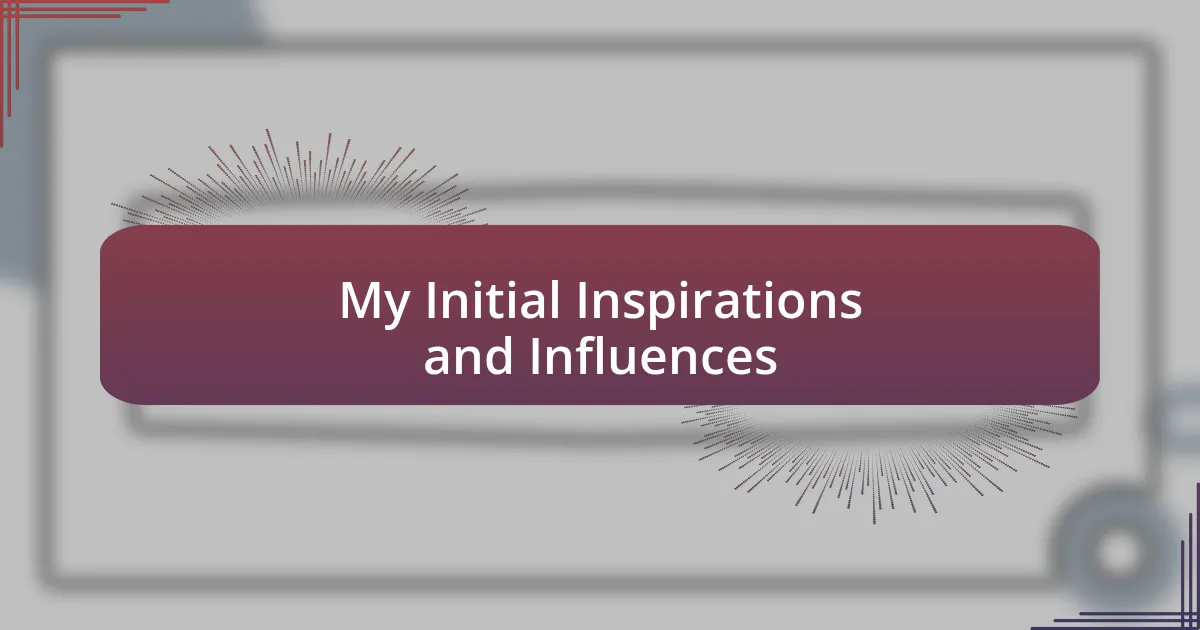
My Initial Inspirations and Influences
As I embarked on my journey into 3D digital art, my early inspirations came from a variety of creative sources. One pivotal influence was the work of renowned artists like H.R. Giger, whose haunting visuals sparked my curiosity. I vividly remember the first time I encountered his art in a science fiction movie. It was a cohesive blend of realism and fantasy that left me captivated. That moment ignited a desire within me to create something just as powerful, to evoke emotions through vivid imagery.
Attending local art fairs and exhibitions also played a significant role in shaping my artistic vision. I recall an encounter with a talented 3D artist who showcased their work; the details and textures left a lasting impression on me. Watching them effortlessly manipulate a digital canvas reminded me of the power of expression in this medium. Their passion was contagious, fueling my own enthusiasm and pushing me to experiment beyond my comfort zone.
Moreover, everyday life has served as a rich tapestry of inspiration. Observing the world around me—the interplay of light and shadow in a cityscape or the intricate designs of nature—has always driven me to recreate those elements in my work. I can still picture a sunset one evening that seemed to glow in a way I had never seen before. Capturing that essence in 3D art became a personal challenge and a profound influence on my creative process.
| Influences | Impact |
|---|---|
| H.R. Giger | Inspires the blend of realism and fantasy in my art. |
| Local Art Exhibitions | Motivated me to experiment and expand my creative boundaries. |
| Everyday Observations | Influenced my approach to light, shadow, and detail. |
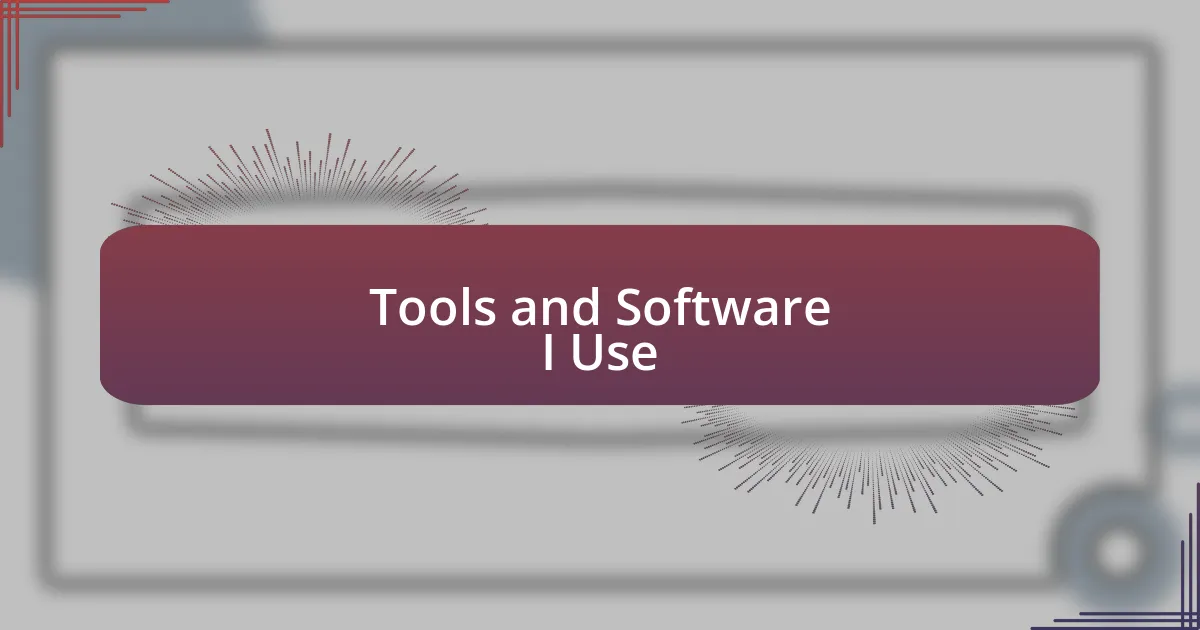
Tools and Software I Use
The tools and software I use play a crucial role in bringing my visions to life. Over the years, I’ve experimented with various programs, each offering unique features that cater to different aspects of my artistic process. I remember my first days using Blender; the user interface initially overwhelmed me, but the possibilities it unlocked for creating intricate models fascinated me. It’s incredible how mastering a tool can shift your entire perspective on what you can create.
Here’s a quick look at the software I rely on:
- Blender: This open-source program is my go-to for 3D modeling and animation. I love its community-driven support and extensive features.
- ZBrush: For detailing my models, ZBrush is fantastic. Its powerful sculpting tools allow me to add lifelike textures and nuances that bring my work to another level.
- Adobe Substance Painter: I find that this software is essential for texturing. The way it allows me to paint directly onto the 3D model is an absolute game-changer.
- Cinema 4D: I sometimes use Cinema 4D for motion graphics; its intuitive interface makes the animation process feel seamless.
- Photoshop: Though primarily known for 2D, I use Photoshop for touch-ups and texture creation; it complements my 3D work effectively.
Each tool has its own learning curve, but the satisfaction that comes from mastering them is profoundly rewarding. The journey of familiarizing myself with these applications has not only helped in honing my skills but also transformed the way I perceive digital art.
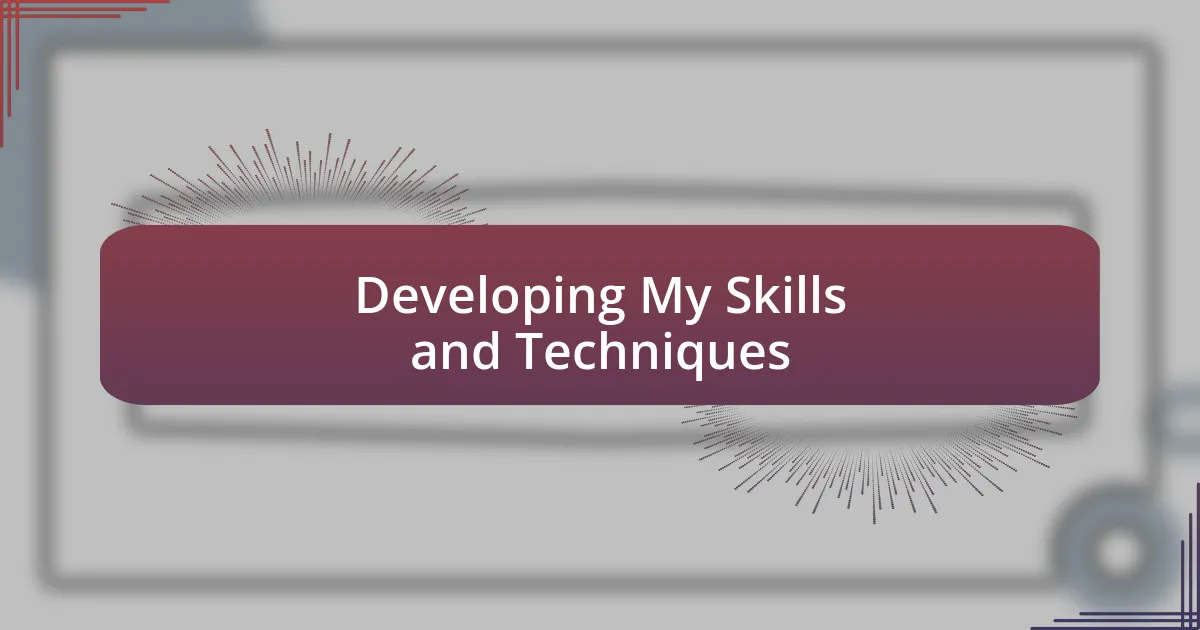
Developing My Skills and Techniques
As I delved deeper into 3D digital art, I realized that practice was just as important as the tools I used. One evening, after countless attempts at sculpting a character’s face, I finally captured the expression I had envisioned. That moment of triumph not only boosted my confidence but also reinforced the idea that persistence pays off in this art form.
I began to seek out tutorials and online courses to refine my techniques. Initially, I felt a bit lost, but I discovered that learning from established artists provided me with fresh perspectives and approaches that I hadn’t considered before. I vividly remember watching a tutorial on ZBrush and being completely captivated by how a simple shape transformed into a detailed dragon. Have you ever experienced that moment when a new technique radically changes your workflow? For me, it was eye-opening.
Collaboration has also been a significant aspect of my skill development. Working alongside other artists not only challenged my abilities but allowed me to gather feedback and insights that I wouldn’t have encountered otherwise. I can still recall a project where a teammate suggested a different lighting technique, and it completely redefined the mood of our piece. Those moments of shared creativity have taught me that improvement isn’t a solitary journey; it’s often enriched by the experiences and ideas of others.
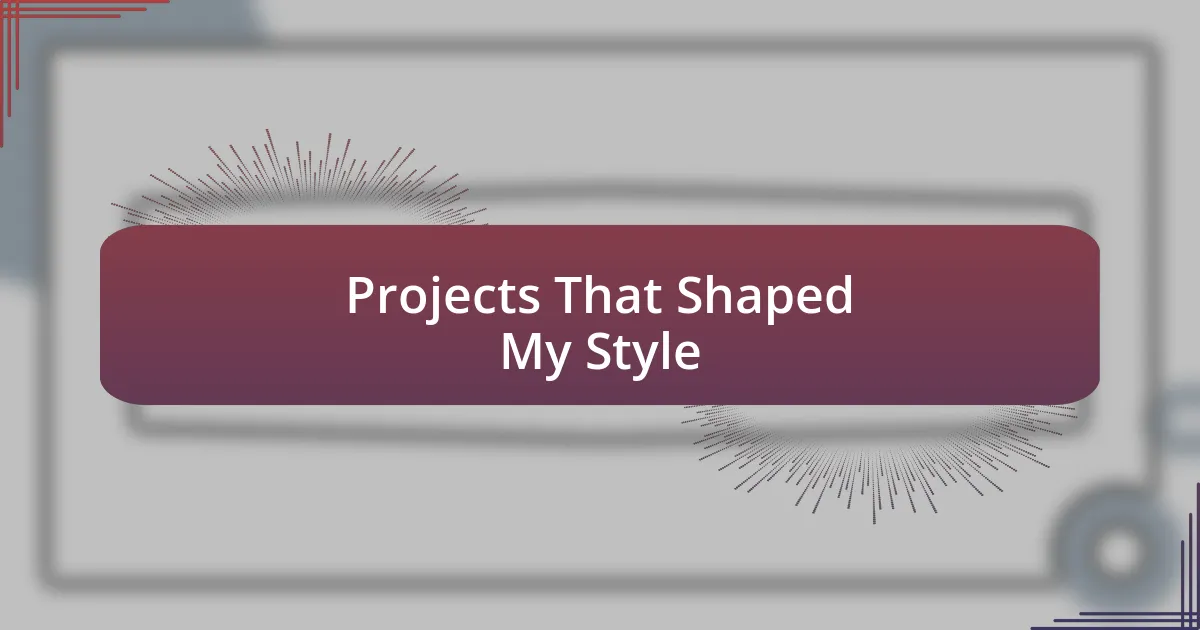
Projects That Shaped My Style
One project that stands out in shaping my style was a personal piece inspired by nature. I set out to recreate a serene forest scene, pouring my heart into each element. The feedback I received from peers was immensely gratifying, but it was the process of blending colors and textures that truly transformed my approach to digital environments. Have you ever felt that a project just clicked with your artistic vision? For me, that forest scene did, and it opened a whole new avenue of creativity.
Another milestone was a collaborative game design project I worked on, which demanded that I push my limits. I was responsible for creating 3D assets like characters and environments, and the deadline was tight. The intensity of that experience taught me the importance of efficiency and planning in my workflow. The excitement of seeing my contributions in motion in a game setting was exhilarating, sparking a newfound passion for interactive art. How has the pressure of a deadline inspired you? For me, it became a catalyst for innovation.
Lastly, I embarked on a passion project that revolved around sci-fi themes, experimenting with lighting and shading in ways I hadn’t attempted before. I vividly recall the moment I applied a new rendering technique I learned online, and the scene came alive with dramatic shadows and highlights. It felt like magic! Each project in my journey adds another layer to my style, reinforcing that exploration is fundamental; I constantly ask myself: what new styles can I try next?
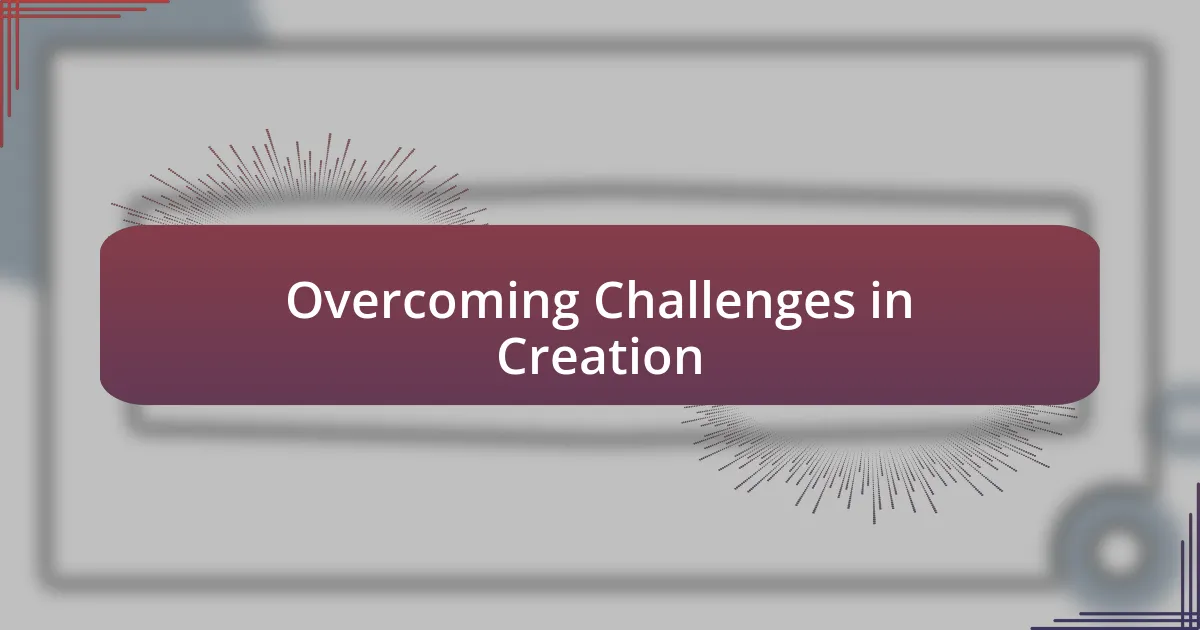
Overcoming Challenges in Creation
Each creation journey often presents unexpected hurdles that can leave us feeling frustrated. I remember a time when I was deeply engrossed in a project and suddenly hit a block with my character design. It felt disheartening, as if my ideas had come to a complete standstill. To overcome this, I took a step back and immersed myself in nature, sketching what I saw. This shift in perspective not only reignited my creativity but also helped me return to my project with fresh inspiration. Have you ever found that stepping away can bring clarity?
In another instance, the technical challenges of software updates baffled me. There was one particular day when my favorite tool changed right before a crucial deadline, and I was terrified I’d miss my chance to deliver. After some deep breaths, I dove into tutorials and forums, rapidly learning the new features. This experience taught me the importance of adaptability in an ever-evolving digital landscape. The moment I successfully used the update to enhance my work felt incredibly rewarding. Don’t you agree that mastering a tool adds a sense of achievement to our creative process?
Lastly, I faced the challenge of self-doubt when sharing my work publicly for the first time. The thought of exposing my artistry to criticism was nerve-wracking. However, I decided to embrace vulnerability by participating in an online art community, and the supportive feedback I received was overwhelming. It was liberating to realize that others shared similar uncertainties, and we could uplift one another. How has community impacted your artistic journey? For me, it transformed my view of feedback as a vital resource rather than a source of fear.

